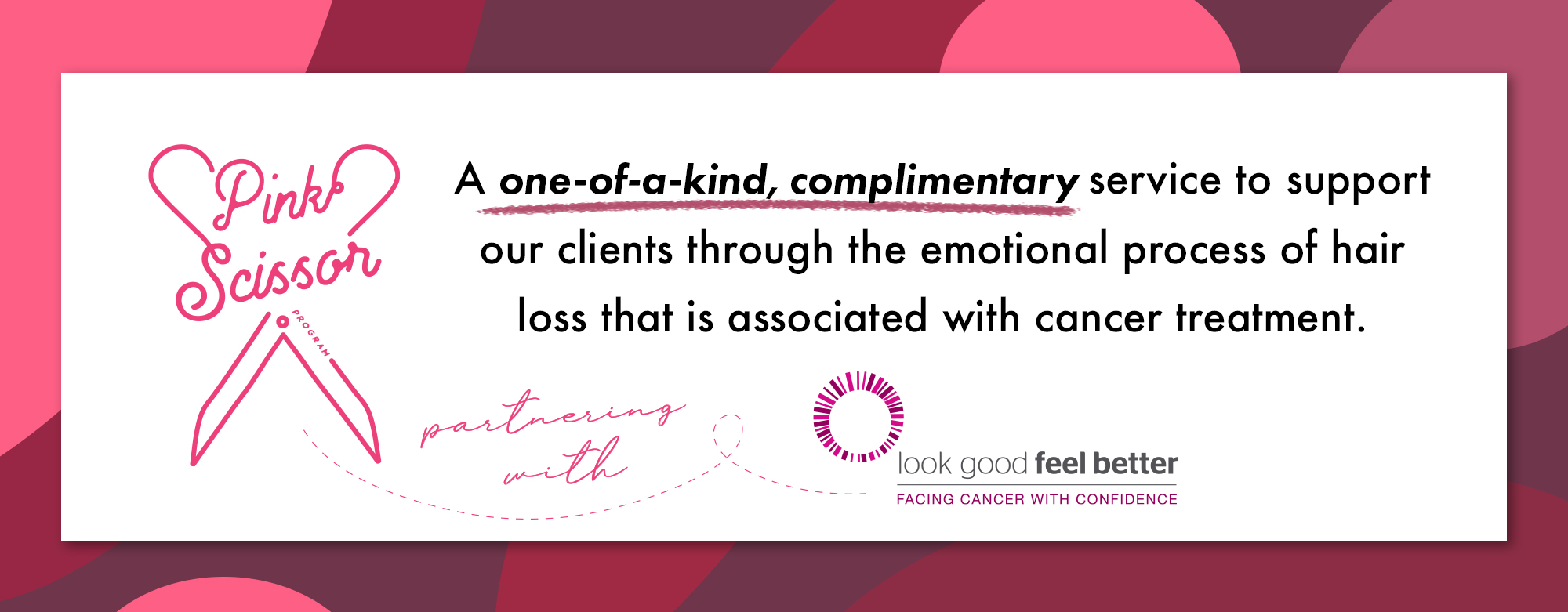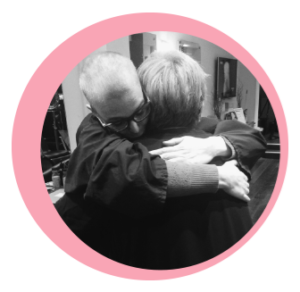
TONI&GUY Australia are proud to support individuals on their journey of fighting cancer. The Pink Scissor Program is a one-of-a-kind complimentary service to support cancer patients through the emotional process of hair loss associated with cancer treatment.
In its eighth year now, the TONI&GUY Pink Scissor Program has supported hundreds of women with specialised hairdressing – providing a safe and supportive space where sensitive hair-care needs are understood and expertly attended to.
TONI&GUY offers the following services to each individual, which may be extended based on their specific needs: Two pre-hair loss haircuts, which are tailored based on hair length ie bob cut to a crop cut, (followed by the use of clippers when necessary).
Two post-chemo return haircuts, scheduled at 8-10 weeks are provided to tidy around the ears, shape the nape, and potentially tidy any rouge chemo curl. At 18-24 weeks, a reshaped haircut is provided.
Here’s how we’re helping individuals
on their journey with cancer…
PINK SCISSOR


YOUR PINK SCISSOR
SPECIALIST
On your first visit, you will meet your Pink Scissor Specialist – a down to earth, experienced & educated hair stylist who will be with you every step of the way…

 MAKING A
MAKING A
HAIR FALL PLAN
Your Pink Scissor Specialist will craft a hair fall plan that is tailored to you. Vulnerability is embraced and thoughtful advice is provided every step of the way…

YOUR CONFIDENCE &
COMFORTABILITY IS OUR PRIORITY
Your Pink Scissor Specialist will guide you on how to select & wear a wig – we’ll touch it up, so it’s 100% tailored to you.

 THROUGH
THROUGH
THICK & THIN
Our Pink Scissor Specialists will keep in touch with you throughout your journey.

A LEADING LIGHT
When the time comes, your Pink Scissor Specialist will guide you to find a cut & colour with helpful advice that is suited to your newly regrown hair.

The Pink Scissor Program has helped those like myself, struggling with horrible hair loss due to chemotherapy for breast cancer.
I was introduced to Maryam, who gracefully and so tenderly cut my hair to almost my scalp. I cannot praise her enough for her understanding of my situation. I have now found a salon that will be my home for many years to come. It is not every day that a
lady is made to feel beautiful under such ugly conditions.
– Marie Mills, Pink Scissor Client
Q&A
Most hair loss during cancer treatment is caused by chemotherapy. Chemotherapy targets rapidly growing cells, damaging hair follicles and causing hair to fall out. Radiation therapy can sometimes cause hair loss, too, when it’s used to treat head and neck cancers. It depends on the area receiving radiation and is normally a specific location to the treatment point.
The straight answer is no. Not all chemotherapy drugs have hair loss as a possible side effect. Everyone has a different response. Some people might lose all of their body hair, while others experience only mild thinning. Check with your care team to find out if it’s a potential side effect of the drugs you’ll be taking.
It generally becomes noticeable after about 2-4 weeks. Head hair usually goes first, followed by hair from other body areas. It can fall out very quickly or gradually over a period of weeks. You’ll likely notice hair on your pillow, in your hairbrush or comb, or in your sink or shower drain, and your scalp may feel tender. Everyone responds differently, so it could be sooner or later, depending on the individual.
No, not really. Some patients try wearing cold caps, which reduces blood flow to the scalp. The idea is to slow down the circulation there during an infusion, so the hair follicles won’t be exposed to as much chemotherapy. But cold caps aren’t always very effective, and many patients still lose at least some of their hair anyway.
Patients usually start seeing regrowth about six weeks after their last treatment.
There is no proven supplement to make your hair grow quicker after chemo. You also don’t want to run the risk of anything you ingest having a negative interaction with the drugs you’re already taking to treat the cancer.
Vitamin E oils are really good for the scalp when there is no hair. They soothe dry itching and heal abrasions. We recommend a hypoallergenic shampoo with low / no perfume in case there is any sensitivity. I would avoid baby shampoos, as they have a different pH balance and can make the hair feel dry.
Everyone’s hair is different, but it’s unusual for changes to be permanent. It’s also rare for hair to never grow back. The difference is usually temporary. Your new hair might have a different texture or colour. It might be curlier than it was before. It also could be grey until the cells that control the pigment in your hair begin working again. If you were colouring your hair prior to treatment, your hair may seem different to what you remember your natural colour to look like. Using a semi-permanent colour is fine to start with and will give you up to 75% coverage of white hair (based on Wella colour). You won’t be able to highlight your hair until there is enough length to weave a foil.
Covering your head as your hair falls out is a personal decision. For many people, hair is associated with personal identity and health. They choose to maintain that look by wearing a wig. Others choose hats and scarves. Still, others choose not to cover their heads at all.
Look Good Feel Better is a national cancer support program. It offers free in-person and online workshops and Confidence Kits to help people with any type of cancer manage the most common physical and psychological impacts of treatment. By providing practical tips and tools, LGFB helps connect a community of people living a shared experience, empowering them to regain control, confidence, and a sense of self.
Ask your healthcare professional or a hospital social worker about resources in your area to help you find the head covering that’s best for you.
Look Good Feel Better is a free program that provides hair and beauty makeovers and tips to women with cancer. These classes are offered throughout Australia.
Wigs are an option. Wigs can range in price depending on if they are natural or synthetic. Natural wigs are more expensive and tend to be much heavier and hotter. You do have the versatility to style them in different ways if you choose. Synthetic wigs have improved greatly, they tend to be lighter but can’t be styled with heat appliances. There are many wig libraries available for you to loan one, which is a great option.
Protecting your skin from the sun is important. Head scarves might be a more comfortable option. They come in beautiful cotton or silk and have many amazing designs and colours.
Your hair loss generally can’t be prevented. However, it can be managed. Consider the following actions to help you cope with hair loss during treatment. Your hair loss generally can’t be prevented. However, it can be managed. Consider the following actions to help you cope with hair loss during treatment.
Be gentle with your hair. Get in the habit of being kind to your hair.
Consider cutting your hair. Short hair tends to look fuller than long hair. As your hair falls out, it won’t be as noticeable if you have short hair. Also, if you have long hair, going short might ease the transition to total hair loss. Cutting your hair into a Long Bob, a short bob, then a crop. This allows you to visualise yourself with shorter hair so you have visual goals to get back to in the regrowth stage.
Plan for a head covering. Now is the time to start thinking about wigs, scarves, or other head coverings. Whether you choose to wear a head covering to hide your hair loss is up to you. We wouldn’t jump straight into prebuying anything at this stage; just know what and where is available. Each person’s journey is individual, and you won’t know what’s right for you until you reach the point.
Baby your remaining hair. Continue your gentle hair routine throughout your chemotherapy treatment. Use a soft brush. Wash your hair only as often as necessary. Consider using a gentle shampoo but not baby shampoo.
Consider shaving your head. Many people find their scalps feel itchy, sensitive, and irritated during their treatments and when their hair falls out. Shaving your head can reduce the irritation and save you from shedding. Just remember, doctors caution against shaving the scalp with a razor. It can cause hard-to-heal cuts that can result in infection when blood counts are low.
Protect your scalp. If your head is going to be exposed to the sun or to cold air, protect it with sunscreen or a head covering. Your scalp may be sensitive as you go through treatment. This means extreme cold, or sunshine can easily irritate it. Having no hair or having less hair can make you feel cold. Wearing a head covering may make you more comfortable.
Continue gentle hair care. Your new hair growth will be especially fragile. It may be more easily damaged by styling products and heating devices on your hair until it grows stronger. Avoid things that could damage your new hair and irritate your sensitive scalp.
Try to be patient. Your hair will likely feel like it’s coming back slowly and that it might not look the same right away. But growth takes time. It also takes time for your body to repair the damage caused by your cancer treatment. But it will.